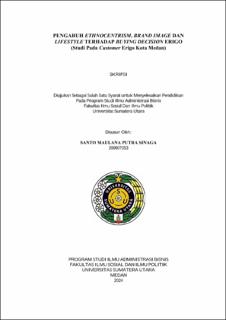| dc.description.abstract | Globalization increases transparency and competition in the fashion industry. The phenomenon of "fashion statement" shows individual freedom in
dressing. Medan City has potential as a fashion market that can influence consumer purchasing decisions. Erigo, one of the local brands, is trying to attract consumers in Indonesia. However, the company still needs to improve ethnocentrism, brand image, and lifestyle to reach consumers in Medan City and help them make buying decisions.
This study aims to determine the effect of Ethnocentrism, Brand Image,
and LifeStyle on Buying Decisions at Erigo Customers in Medan City. The effect
of Ethnocentrism, Brand Image, and LifeStyle will be analyzed partially and simultaneously on buying decisions.
The research used is quantitative with an associative approach. The population in this study were Erigo consumers in Medan City, with a sample of 96 respondents, with sampling techniques using purposive sampling. Primary data was obtained through the direct distribution of questionnaires, and secondary data was obtained through literature studies. The data analysis methods used are instrument tests, classical assumption tests, multiple linear regression analyses,
and hypothesis testing.
The results of this study indicate that Ethnocentrism has a positive and
significant effect on the Buying Decision variable; the t-count value is 2.671> 1.986 with a significance level of 0.009 <0.05 and a regression coefficient value
of 0.460. Brand Image has a positive and significant effect on the Buying Decision
variable; the t-count value is 4.955> 1.986 with a significance level of 0.000 <0.05 and a regression coefficient value of 0.739. Lifestyle has a positive and
significant effect on the Buying Decision variable, obtained a t-count value of 2.703> 1.986 with a significance level of 0.008 <0.05 and a regression coefficient of 0.411. In simultaneous testing, Ethnocentrism, Brand Image, and Lifestyle variables simultaneously influence 41.7%, while factors outside this research model influence the remaining 58.3%. | en_US |


